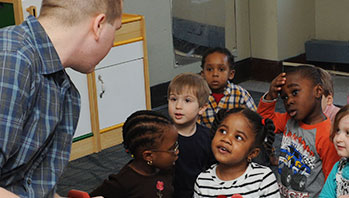- “All About Ramps” chart
- children’s ramps
- marker
- objects to roll and slide (water bottle, tin can, craft stick, block, etc.)
- pictures/photos of ramps
- small ramp
- down
- ramp
- roll
- slide (v.)
MA Standards:
English Language Arts/Speaking and Listening/SL.PK.MA.1: Participate in collaborative conversations with diverse partners during daily routines and play.
English Language Arts/Language/L.PK.MA.1: Demonstrate use of oral language in informal everyday activities.
MA Draft Standards:
Physical Sciences/Motion and Stability; Forces and Interaction /PS2.B: Using evidence, discuss ideas about what is making something move the way it does and how some movements can be controlled. [Cause and Effect, Stability and Change]
Head Start Outcomes:
Logic and Reasoning/Reasoning and Problem Solving: Recognizes cause and effect relationships.
Science Knowledge/Scientific Skills and Method: Collects, describes, and records information through discussions, drawings, maps, and charts.
PreK Learning Guidelines:
English Language Arts/Language 2: Participate actively in discussions, listen to the ideas of others, and ask and answer relevant questions.
English Language Arts/Language 3: Communicate personal experiences or interests.
Talk Together: Introduce Sliding

© Commonwealth of Massachusetts, Department of Early Education and Care (Jennifer Waddell photographer). All rights reserved.
STEM Key Concepts: A ramp or an inclined plane, is a surface with one end higher than the other; An object placed on an inclined plane will roll, slide, or stay put; The shape of an object affects how it moves down a ramp; Objects that slide are more likely to move on steeper inclines; Rolling and sliding objects move faster down steeper inclines; The texture of an object or a surface affects the motion and speed of a rolling or sliding object
ELA Focus Skills: Predicting, Speaking and Listening, Vocabulary
Gather any drawings children made during their explorations of ramps. Ask children to describe their drawings and what they’ve learned about ramps so far. Ask questions such as,
- What did you notice when you made the ramp higher?
- Why do you think the tin can stopped before it got all the way down the ramp?
Have children gather near one of the children’s ramps. Hold up a water bottle and discuss the shape and size of it. Then roll it down the ramp. Have children use key vocabulary words such as zoom, zip, fast, faster, slow, and slower to describe the rolling movement. Then hold up a block and compare the shape and size to the bottle. Ask children what they think will happen when you put the block on the ramp. Place a block on the ramp and watch it slide down. Have children describe the block’s movement. Ask,
- Why do you think the block moved differently than the ball?
- What is different about the shape of the bottle as compared to the shape of the block?
- What is different about the way the objects feel when you hold them? (heavy/light, round, square, smooth/bumpy, etc.)
- What did you notice about how fast each object moved?
If children don’t offer the word slide, then say as you act out each movement with hand motions, When the bottle moves down the ramp, it rolls down. But when the block moves down the ramp, it slides down.
Have children find pictures from the collection of ramp pictures or draw pictures to add to the “All About Ramps” chart.
Educator Tip: You may want to take this opportunity to reinforce the multiple meanings of the word slide.
English Language Learners: Whenever possible, demonstrate word meanings with gestures and facial expressions. Have children repeat the words and the gestures after you and then repeat them together again.
